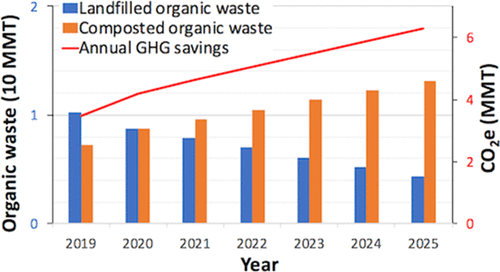当前位置:
X-MOL 学术
›
Environ. Sci. Technol.
›
论文详情
Our official English website, www.x-mol.net, welcomes your
feedback! (Note: you will need to create a separate account there.)
Quantifying the Farmland Application of Compost to Help Meet California's Organic Waste Diversion Law.
Environmental Science & Technology ( IF 10.8 ) Pub Date : 2020-03-23 , DOI: 10.1021/acs.est.9b05377 Brendan P Harrison 1 , Evan Chopra 1 , Rebecca Ryals 2 , J Elliott Campbell 1
Environmental Science & Technology ( IF 10.8 ) Pub Date : 2020-03-23 , DOI: 10.1021/acs.est.9b05377 Brendan P Harrison 1 , Evan Chopra 1 , Rebecca Ryals 2 , J Elliott Campbell 1
Affiliation

|
California’s landmark waste diversion law, SB 1383, mandates the diversion of 75% of organic waste entering landfills by 2025. Much of this organic waste will likely be composted and applied to farms. However, compost is expensive and energy intensive to transport, which limits the distance that compost can be shipped. Though the diversion of organic waste from landfills in California has the potential to significantly reduce methane emissions, it is unclear if enough farmland exists in close proximity to each city for the distribution of compost. To address this knowledge gap, we develop the Compost Allocation Network (CAN), a geospatial model that simulates the production and transport of waste for all California cities and farms across a range of scenarios for per capita waste production, compost application rate, and composting conversion rate. We applied this model to answer two questions: how much farmland can be applied with municipal compost and what percentage of the diverted organic waste can be used to supplement local farmland. The results suggest that a composting system that recycles nutrients between cities and local farms has the potential to play a major role in helping California meet SB 1383 while reducing state emissions by −6.3 ± 10.1 MMT CO2e annually.
中文翻译:

量化堆肥在农田中的应用,以帮助实现加利福尼亚的有机废物转移法。
加利福尼亚州具有里程碑意义的废物转移法SB 1383规定,到2025年,必须将75%的有机废物转移到垃圾填埋场。大部分有机废物可能会被堆肥并用于农场。然而,堆肥昂贵且运输耗能,这限制了堆肥可以运输的距离。尽管从加利福尼亚州的垃圾掩埋场转移有机废物有潜力显着减少甲烷排放,但尚不清楚每个城市附近是否有足够的农田来分配堆肥。为了解决这一知识鸿沟,我们开发了堆肥分配网络(CAN),这是一种地理空间模型,可以模拟加州所有城市和农场在人均废物产生,堆肥施用率和堆肥的各种场景下的废物产生和运输兑换率。我们使用此模型回答了两个问题:市政堆肥可用于多少农田,以及转移的有机废物中有多少百分比可用于补充当地农田。结果表明,在城市和当地农场之间循环利用营养的堆肥系统在帮助加利福尼亚州满足SB 1383标准同时将州排放量降低-6.3±10.1 MMT CO方面具有重要作用每年2 e。
更新日期:2020-03-24
中文翻译:

量化堆肥在农田中的应用,以帮助实现加利福尼亚的有机废物转移法。
加利福尼亚州具有里程碑意义的废物转移法SB 1383规定,到2025年,必须将75%的有机废物转移到垃圾填埋场。大部分有机废物可能会被堆肥并用于农场。然而,堆肥昂贵且运输耗能,这限制了堆肥可以运输的距离。尽管从加利福尼亚州的垃圾掩埋场转移有机废物有潜力显着减少甲烷排放,但尚不清楚每个城市附近是否有足够的农田来分配堆肥。为了解决这一知识鸿沟,我们开发了堆肥分配网络(CAN),这是一种地理空间模型,可以模拟加州所有城市和农场在人均废物产生,堆肥施用率和堆肥的各种场景下的废物产生和运输兑换率。我们使用此模型回答了两个问题:市政堆肥可用于多少农田,以及转移的有机废物中有多少百分比可用于补充当地农田。结果表明,在城市和当地农场之间循环利用营养的堆肥系统在帮助加利福尼亚州满足SB 1383标准同时将州排放量降低-6.3±10.1 MMT CO方面具有重要作用每年2 e。









































 京公网安备 11010802027423号
京公网安备 11010802027423号